954
Mi-Mi-Mi of the 2nd or "glass" to "crocodile"
Writes saoirse-2010:
Finally, some free time and I got to my blog. In late February this year, I posted the first part of the site where the helicopters are preserved, which was devoted to the MI-8 helicopter. In the second part, as I promised, it will be helicopters Mil - Mi-24, which is the same as the legendary Eight sad standing in a row on the former's GDP.
22 photos under the cut

01. Telling the second time, we got to this place, I will not, so I move on to the history of MI-24.
It all started in the early 60s and evolved in a similar scenario as with the Mi-8. The military leadership, as usual, was not thrilled with the idea of appearance, something fundamentally new, preferring well-proven old equipment. So Michael Leontievich Mile more than one year had to spend to get the go-ahead for the creation of a new helicopter. When Miles in 1963 first proposed the development of the first Soviet gunship dedicated his idea Defense Minister R. I. Malinowski met, to put it mildly cold. Accordingly, in the next five-year plan for the project has not got. But as in the case of the Mi-8 was the turning point the Vietnam War, in which US Army pioneered the use of specialized military helicopters Bell AH-1 Cobra. Their use in Vietnam has been very successful and demonstrated the excellent potential of this type of aircraft during the fighting. All these add to the arguments in favor of Mile similar combat vehicles.
In 1967, Michael Miles persuaded the government to hold a council on a new type of helicopter - martial. Though the consensus reached in the Council failed Mil and Kamov design bureau was invited to develop a technical proposal of an armed helicopter. Since Michael Miles did not wait for the sea weather already had his CB operating time and eventually was developed not one, but two tehpredlozheniya. First - single-engine helicopter, weighing 7 tons, the second - the twin-engine weighing 10, 5 tons. Kamov design bureau just followed the path of least resistance and simply offer a cheap and easy option: to equip weapons has already used a helicopter KA-25. As a result of the senior military leadership like twin-engine version of the proposal Mil. The new machine had the working title of the B-24.

02. Work on the project began sketch in May 1968 under the leadership of Mil. In February 1969 a government commission approved it, and in June of the same year he built the first prototype. This rapid rate of creation of the first sample was due to the fact that the main components have been unified with the helicopter MI-8 and MI-14. September 19, 1969 B-24 made its first flight.
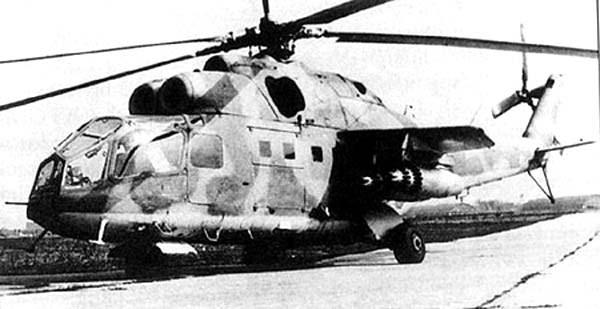
03. In June 1970 began public testing machines, which lasted one and a half years. During the tests to improve stability was changed angle of the wing. Just antitank system "Phalanx" was moved from near the fuselage frames for special pylons mounted on the wingtips of the fact that there was a danger when you start to get into your rocket as the fuselage. The cabin also underwent a change, it had to extend to it climbed sighting and targeting systems.
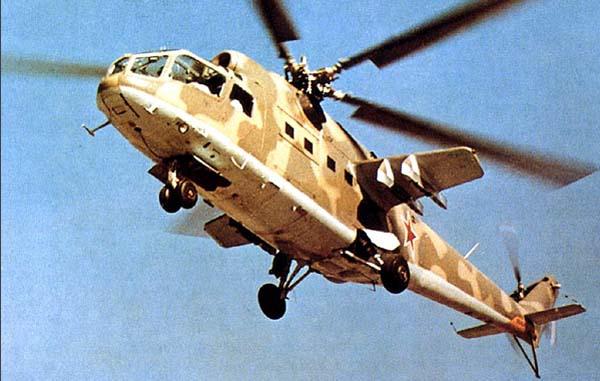
04. By the end of 1970 prototypes were changed and the helicopter was actually ready, and before the planned service. Therefore, mass production, which began in 1971, went to MI-24A version with a simpler anti-complex "Falanga-M" and the gun A-12 7. In just five years, was released about 250 pieces. It was then that there was a first nickname - "glass" cockpit for the similarity with faceted product.
Of course, this work did not end with weapons. A new version of the Mi-24B which put the mobile machine gun USPU-24 machine gun Yak B-12 7. Updated antitank system with "Phalanx-M" to "Phalanx-P", improved guidance system and aiming now helicopter during these Action could maneuver in the range of 60 degrees, which greatly enhanced its combat effectiveness.
But, suddenly, because of the problems identified during the operation of the helicopter Mi-24A further development of the project were suspended.
MI-24A

05. The main flaw was the shower. First there was a bad review, and secondly because of the fact that the pilot and the operator sat next to one successful hit in combat, could deprive the helicopter crew. The situation with the shower decided fairly quickly. Already in early 1971, it has been completely redesigned bow. Now, the pilot and the operator were in different armored cab and at different heights. In addition to this it was provided a broad overview of the unit of observation "Raduga-F." The changes were made and the tail rotor, it was moved from the right side to the left and began to rotate in the opposite direction. Externally, the helicopter found the familiar look and got a new nickname - "Crocodile".

06. Planned armament of MI-24 still was not ready, so in 1973 he published an intermediate version of the MI-24D with ATGM "phalanx - P". Two years later, it was finally finished debugging complex with supersonic anti-tank guided missiles - "Sturm - In" and it began to be installed on a helicopter to get the index MI-24V. In 1975, this helicopter was set a number of records including an absolute speed record (368, 4 km.h), which lasted 10 years.
March 29, 1976 decision of the government of the USSR MI-24D and MI-24V stood adopted country by this time was already in service about 400 machines in different versions.

07. Helicopter for service in the army was used in three main variations:
1) Combat - destruction of tanks, support for ground troops, the destruction of point targets and manpower.
2) Transportation - landing and his cover, freight and supply of advanced army units.
3) Sanitary - transportation of the wounded.

08. There are other types of machines, such as Mi-24P - Helicopter radiation and chemical control. It wingtip pylons in place for anti-tank systems installed excavator fence ground and instead of guns raised pylon with special equipment. These helicopters are working in Chernobyl for mapping radioactive contamination. A total of 160 pieces were produced, and no less than ten stands on conservation, in this place.
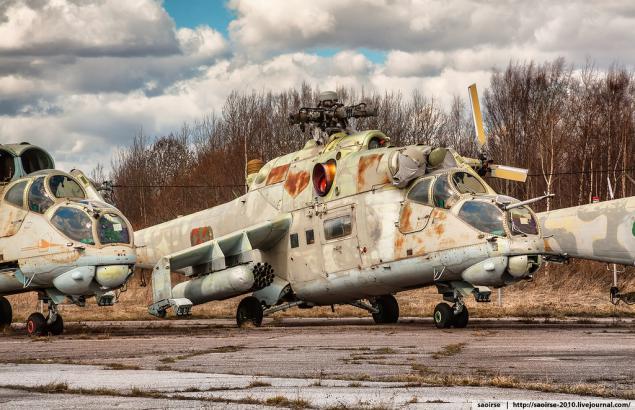
09. Another interesting modification was the Mi-24P. The focus there was directed at increasing firepower by using the side 30-mm cannon GSH-30K. With the installation of the gun appeared quite a few problems, as a result of a series of release, the helicopter was only 6 years later. I mentioned MI-24P is not accidental, that the development of this version is the resurgence of "crocodile" in Russia today, but more on that later.
Helicopters of this modification on the court I did not notice, but my luck in a couple of kilometers away from the canned machines was found MI-24P in updated form on the existing military facility.

10. His first baptism of fire MI-24 passed in the next year, after adopting the Soviet army in the Ethiopian-Somali war (1977-1978), where the helicopters showed himself perfectly. Of course, this was not the only war involving the Soviet attack helicopters. Total used them in more than 30 wars and armed conflicts, which is not surprising, because the Mi-24 was exported to more than a dozen countries in Africa and Asia, and these countries have always loved to war with each other.

11. The most important conflict influenced the development of the helicopter was the war in Afghanistan. With the advent of the Mujahideen portable air defense systems with heat-seeking Soviet troops urgently had to install protection against these missiles on the helicopters, so there were infrared lamps to shoot flares and screen-exhaust apparatus on engines that have masked the heat emanating from them. An important and has protection against dust knots.
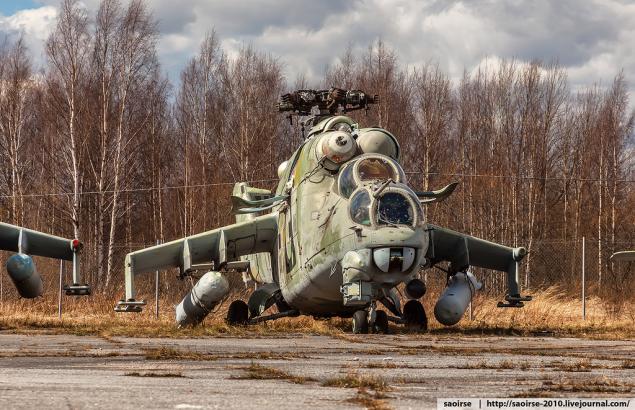
12. In the context of the war very much, by the way was the interchangeability of parts MI-8 and MI-24, as well as high survivability of the helicopter, the basic system of the helicopter were dubbed. For example, the fuel system had five soft-sealing tanks capacity of 2125 liters. and the fuel supply is not interrupted in case of damage of any of them. Armored cockpit and the operator saved more than one life from small arms. Even if the enemy and managed to severely damage the car and she somehow got to the airport, high maintainability in most cases, to get it back into operation by the rembrigady at the airport.
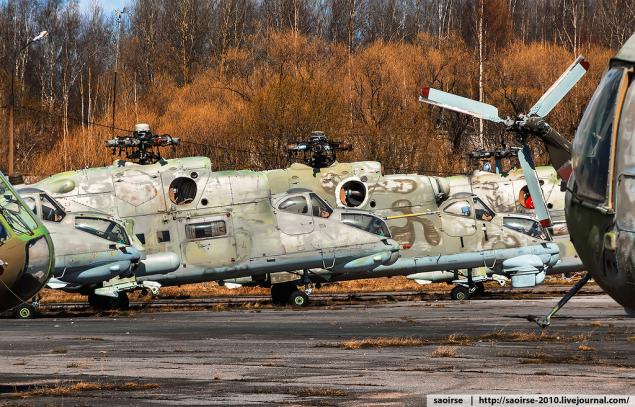
13. Unfortunately, no matter how tenacious was not this machine, invulnerable she failed to become so in the mountains of Afghanistan were destroyed 127 pieces of Mi-24 helicopters.

14. In 1989, the war ended, and in the same year in the series was released last Soviet attack helicopter Mil - Mi-24VP. Its main difference was the replacement of the gun GSH-30K, the power of which was too excessive for dvuhstvolny gun GSH-23L That such weapons Mikhail Mil and would like to see on the Mi-24 helicopter.

15. With the collapse of the Soviet Union the "crocodile" began the most difficult time in the early '90s series production was stopped. Part of the once large helicopter fleet remained in the already independent countries that were once one large state - the USSR. Some began to sell to third world countries

16. In the second half of the 90s, again, work began on the modernization of Mi-24.
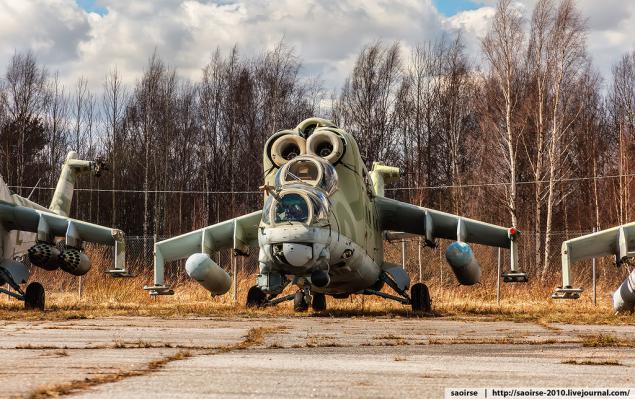
17. Old machinery began to restore and replace outdated equipment with more modern.
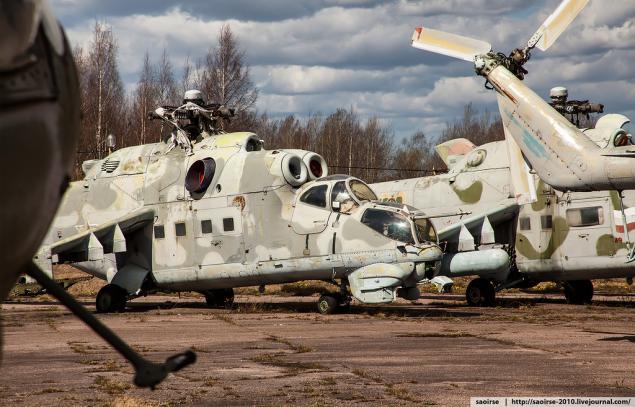
18. But time is still lost, foreign helicopters that ceaselessly modernized become significantly ahead of the effectiveness of MI-24. Therefore Mil in the mid-90s began work on a new modernization "crocodile." The basis was taken MI-24VP, which changed the tail rotor to a more modern X-shaped; fiberglass blades made; rotor head became titanium; the engine has been updated; chassis - non-retractable. This helicopter was the index - MI-24VM. In 1999 he made his first flight, and since 2000 began serial production. The main customer of the new Mi-24VM was the Ministry of Defence of the Russian Federation.
Thanks to this upgrade is planned to extend the life of Mi-24 helicopters for 10-15 years. Mi-24VM found himself in demand in other countries, under the symbol Mi-35M it comes to Latin America, Africa and Asia.
Total production for the time and in the USSR and Russia was released about 3,500 copies of the MI-24

19. At the end add some photos that managed to do near mothballed helicopters.

20. People in camouflage here constantly appeared near the buildings, so to come close to the helicopters we could not.

21. MI-24RHR.

22. In this photo with empty units for rockets and I finish the review. I'll try to write more often.

Source:
Finally, some free time and I got to my blog. In late February this year, I posted the first part of the site where the helicopters are preserved, which was devoted to the MI-8 helicopter. In the second part, as I promised, it will be helicopters Mil - Mi-24, which is the same as the legendary Eight sad standing in a row on the former's GDP.
22 photos under the cut

01. Telling the second time, we got to this place, I will not, so I move on to the history of MI-24.
It all started in the early 60s and evolved in a similar scenario as with the Mi-8. The military leadership, as usual, was not thrilled with the idea of appearance, something fundamentally new, preferring well-proven old equipment. So Michael Leontievich Mile more than one year had to spend to get the go-ahead for the creation of a new helicopter. When Miles in 1963 first proposed the development of the first Soviet gunship dedicated his idea Defense Minister R. I. Malinowski met, to put it mildly cold. Accordingly, in the next five-year plan for the project has not got. But as in the case of the Mi-8 was the turning point the Vietnam War, in which US Army pioneered the use of specialized military helicopters Bell AH-1 Cobra. Their use in Vietnam has been very successful and demonstrated the excellent potential of this type of aircraft during the fighting. All these add to the arguments in favor of Mile similar combat vehicles.
In 1967, Michael Miles persuaded the government to hold a council on a new type of helicopter - martial. Though the consensus reached in the Council failed Mil and Kamov design bureau was invited to develop a technical proposal of an armed helicopter. Since Michael Miles did not wait for the sea weather already had his CB operating time and eventually was developed not one, but two tehpredlozheniya. First - single-engine helicopter, weighing 7 tons, the second - the twin-engine weighing 10, 5 tons. Kamov design bureau just followed the path of least resistance and simply offer a cheap and easy option: to equip weapons has already used a helicopter KA-25. As a result of the senior military leadership like twin-engine version of the proposal Mil. The new machine had the working title of the B-24.

02. Work on the project began sketch in May 1968 under the leadership of Mil. In February 1969 a government commission approved it, and in June of the same year he built the first prototype. This rapid rate of creation of the first sample was due to the fact that the main components have been unified with the helicopter MI-8 and MI-14. September 19, 1969 B-24 made its first flight.

03. In June 1970 began public testing machines, which lasted one and a half years. During the tests to improve stability was changed angle of the wing. Just antitank system "Phalanx" was moved from near the fuselage frames for special pylons mounted on the wingtips of the fact that there was a danger when you start to get into your rocket as the fuselage. The cabin also underwent a change, it had to extend to it climbed sighting and targeting systems.

04. By the end of 1970 prototypes were changed and the helicopter was actually ready, and before the planned service. Therefore, mass production, which began in 1971, went to MI-24A version with a simpler anti-complex "Falanga-M" and the gun A-12 7. In just five years, was released about 250 pieces. It was then that there was a first nickname - "glass" cockpit for the similarity with faceted product.
Of course, this work did not end with weapons. A new version of the Mi-24B which put the mobile machine gun USPU-24 machine gun Yak B-12 7. Updated antitank system with "Phalanx-M" to "Phalanx-P", improved guidance system and aiming now helicopter during these Action could maneuver in the range of 60 degrees, which greatly enhanced its combat effectiveness.
But, suddenly, because of the problems identified during the operation of the helicopter Mi-24A further development of the project were suspended.
MI-24A

05. The main flaw was the shower. First there was a bad review, and secondly because of the fact that the pilot and the operator sat next to one successful hit in combat, could deprive the helicopter crew. The situation with the shower decided fairly quickly. Already in early 1971, it has been completely redesigned bow. Now, the pilot and the operator were in different armored cab and at different heights. In addition to this it was provided a broad overview of the unit of observation "Raduga-F." The changes were made and the tail rotor, it was moved from the right side to the left and began to rotate in the opposite direction. Externally, the helicopter found the familiar look and got a new nickname - "Crocodile".

06. Planned armament of MI-24 still was not ready, so in 1973 he published an intermediate version of the MI-24D with ATGM "phalanx - P". Two years later, it was finally finished debugging complex with supersonic anti-tank guided missiles - "Sturm - In" and it began to be installed on a helicopter to get the index MI-24V. In 1975, this helicopter was set a number of records including an absolute speed record (368, 4 km.h), which lasted 10 years.
March 29, 1976 decision of the government of the USSR MI-24D and MI-24V stood adopted country by this time was already in service about 400 machines in different versions.

07. Helicopter for service in the army was used in three main variations:
1) Combat - destruction of tanks, support for ground troops, the destruction of point targets and manpower.
2) Transportation - landing and his cover, freight and supply of advanced army units.
3) Sanitary - transportation of the wounded.

08. There are other types of machines, such as Mi-24P - Helicopter radiation and chemical control. It wingtip pylons in place for anti-tank systems installed excavator fence ground and instead of guns raised pylon with special equipment. These helicopters are working in Chernobyl for mapping radioactive contamination. A total of 160 pieces were produced, and no less than ten stands on conservation, in this place.

09. Another interesting modification was the Mi-24P. The focus there was directed at increasing firepower by using the side 30-mm cannon GSH-30K. With the installation of the gun appeared quite a few problems, as a result of a series of release, the helicopter was only 6 years later. I mentioned MI-24P is not accidental, that the development of this version is the resurgence of "crocodile" in Russia today, but more on that later.
Helicopters of this modification on the court I did not notice, but my luck in a couple of kilometers away from the canned machines was found MI-24P in updated form on the existing military facility.

10. His first baptism of fire MI-24 passed in the next year, after adopting the Soviet army in the Ethiopian-Somali war (1977-1978), where the helicopters showed himself perfectly. Of course, this was not the only war involving the Soviet attack helicopters. Total used them in more than 30 wars and armed conflicts, which is not surprising, because the Mi-24 was exported to more than a dozen countries in Africa and Asia, and these countries have always loved to war with each other.

11. The most important conflict influenced the development of the helicopter was the war in Afghanistan. With the advent of the Mujahideen portable air defense systems with heat-seeking Soviet troops urgently had to install protection against these missiles on the helicopters, so there were infrared lamps to shoot flares and screen-exhaust apparatus on engines that have masked the heat emanating from them. An important and has protection against dust knots.

12. In the context of the war very much, by the way was the interchangeability of parts MI-8 and MI-24, as well as high survivability of the helicopter, the basic system of the helicopter were dubbed. For example, the fuel system had five soft-sealing tanks capacity of 2125 liters. and the fuel supply is not interrupted in case of damage of any of them. Armored cockpit and the operator saved more than one life from small arms. Even if the enemy and managed to severely damage the car and she somehow got to the airport, high maintainability in most cases, to get it back into operation by the rembrigady at the airport.

13. Unfortunately, no matter how tenacious was not this machine, invulnerable she failed to become so in the mountains of Afghanistan were destroyed 127 pieces of Mi-24 helicopters.

14. In 1989, the war ended, and in the same year in the series was released last Soviet attack helicopter Mil - Mi-24VP. Its main difference was the replacement of the gun GSH-30K, the power of which was too excessive for dvuhstvolny gun GSH-23L That such weapons Mikhail Mil and would like to see on the Mi-24 helicopter.

15. With the collapse of the Soviet Union the "crocodile" began the most difficult time in the early '90s series production was stopped. Part of the once large helicopter fleet remained in the already independent countries that were once one large state - the USSR. Some began to sell to third world countries

16. In the second half of the 90s, again, work began on the modernization of Mi-24.

17. Old machinery began to restore and replace outdated equipment with more modern.

18. But time is still lost, foreign helicopters that ceaselessly modernized become significantly ahead of the effectiveness of MI-24. Therefore Mil in the mid-90s began work on a new modernization "crocodile." The basis was taken MI-24VP, which changed the tail rotor to a more modern X-shaped; fiberglass blades made; rotor head became titanium; the engine has been updated; chassis - non-retractable. This helicopter was the index - MI-24VM. In 1999 he made his first flight, and since 2000 began serial production. The main customer of the new Mi-24VM was the Ministry of Defence of the Russian Federation.
Thanks to this upgrade is planned to extend the life of Mi-24 helicopters for 10-15 years. Mi-24VM found himself in demand in other countries, under the symbol Mi-35M it comes to Latin America, Africa and Asia.
Total production for the time and in the USSR and Russia was released about 3,500 copies of the MI-24

19. At the end add some photos that managed to do near mothballed helicopters.

20. People in camouflage here constantly appeared near the buildings, so to come close to the helicopters we could not.

21. MI-24RHR.

22. In this photo with empty units for rockets and I finish the review. I'll try to write more often.

Source:
























